Useful Service Life Evaluation Testing of Copper Tubing for Gas Distribution System in California
Copper Applications in Metallurgy of Copper & Copper Alloys, and Plumbing
Summary | Background | Test Set-Up | Key Test Results | Conclusions | Notes
Summary 
In the 1970’s, there had been anecdotal reports of customers in Southern California service area experiencing field problems caused by blockage of orifices or regulators due to flaking of copper tubing. Generally, such flake formation is caused by the presence of excessive sulfides and moisture in the supplied gas. None of these resulted in puncture or leaking of gas and were customer service problems and not safety related concerns. As a result, copper has not been widely used in California for residential fuel gas distribution.
The CDA decided to address this issue by launching an objective test program in cooperation with the Southern California Gas Company [a unit of Sempra Energy] which is the leading gas utility serving Southern California. The test program’s objectives were to evaluate and qualify the susceptibility of both bare copper tube and tin-lined copper tube to corrosion and hydrogen sulfide attack when conveying gas typically supplied to the Southern California Gas Company service areas.
This paper presents the result from this test program, along with the key details of the test program. These include the scope of work, the test set-up, summary of test results and the conclusions based on analysis of the test results. The final overall conclusion was that both the bare copper tubing and the tin-lined copper tubing evaluated in this test met the performance criteria to indicate that they will maintain structural integrity in the context of a 20-year useful life even though signs of sulfide corrosion were observed in the test samples. The extent of the observed corrosion was not severe enough to result in through-the-wall type corrosion.
Background 
Copper tube is an acceptable piping material for fuel gas systems in all major model fuel gas codes in the United States including the ANSI Z223.1/NFPA 54 National Fuel Gas Code (NFGC), and has been accepted in this code since its inception in 1974. In addition to the model codes, many state and local jurisdictions have accepted the use of copper tube in this application for many years, some dating back to the 1950s. During this time copper has proven to be a safe and reliable material for fuel gas distribution systems.
Not only is copper not a new material for fuel gas distribution systems, having a proven safe and reliable track record in jurisdictions throughout the country, it is also not a new material in the California Plumbing, Mechanical, and Building Codes with many years of proven, acceptable performance in California’s buildings. It is also in use in a wide variety of piping systems, including the transport of safe, potable water, medical gases, and even LP gas in California’s homes and buildings for quite some time. In fact, over 50 million pounds of copper tube is installed in buildings within the state of California each year.
Misconceptions and misunderstandings abound with regard to using copper for natural gas distribution systems. These arise from the issue of sulfur compounds carried in the natural gas. Sulfur compounds in the gas stream do have the potential to react with copper to form cuprous sulfide that can scale the tube surface. While the scale is tightly adhering to the tube wall, differences in thermal coefficients of expansion between the tube and scale can cause the scale to flake off. In the past, gas supplies with high levels of sulfur compounds experienced this kind of flaking.
Past research indicated maximum levels of sulfide compounds required to prevent this kind of scaling [See Gas Research Institute: Gas Composition Effects on Interior Gas Distribution Systems, December 1993]. These requirements are reflected (along with significant margins of safety) in the various Model Codes that allow copper to be used for natural gas piping as a maximum of 0.3 grains of hydrogen sulfide per 100 cubic feet of gas. This is also reflected in the Public Utilities Commission of the State of California, “Standards for Gas Service in the State of California” which specifically requires gas supplies to contain no more that 0.25 grains of hydrogen sulfide per 100 cubic feet. If in fact, gas supplies in California meet this standard, then copper tube can be used in the state without any significant sulfide flaking.
But, there is no available data from testing that was done to specifically address the question of how copper tubing will perform in California with the gas that is typically supplied by the local gas company to homes there. The purpose of the test program was to specifically answer the question by setting up a test program in California in one of the test facilities of the Southern California Gas Company. The test was done in cooperation with the gas company which is equally interested in having objective results from such testing.
This article presents the key test results from exposing bare and tin-lined copper tubing to a natural gas environment that is typical of gas composition in the Southern California Gas Company territory. These samples were subjected to a flowing gas stream for a period of 52 weeks. During this period the test assembly received a total flow volume of natural gas equivalent to 15.96 years of average residential gas usage. The primary objective of this study was to evaluate and qualify the susceptibility of both bare copper tube and tin-lined copper tube to corrosion and hydrogen sulfide attack when conveying gas typically supplied to the Southern California Gas Company service areas.
Test Set-Up 
The copper tubing test rack assembly was designed to simulate flow conditions that are representative of a typical full-scale residential house-line. It was configured to hold 4 sets of 1/2” copper tubing samples of 1 ft length mounted on the test rack to be removed after specified exposure periods (Figure 1). These samples were exposed to flowing natural gas for periods of 4, 12, 24 and 52 weeks. Using an average houseline usage of 219,000 cubic feet/year, the accelerated testing at specified exposure period was equivalent to the following usage in years; 4 weeks = 1.23 years, 12 weeks = 3.68 years; 24 weeks = 7.36 years and 52 weeks = 15.96 years. This is equivalent to a continuous gas flow of 400 cfh.
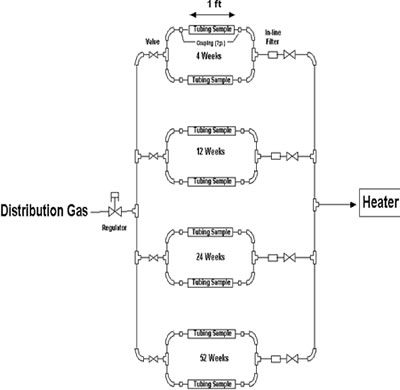 Figure 1. Test Rack Assembly
Figure 1. Test Rack AssemblyAfter each exposure period, the bare and tin-lined tubing samples were removed and evaluated for general appearance, tubing material loss, corrosion product and internal corrosion deposit. Each sample was weighed to determine material loss due to corrosion before and after the exposure period. Corrosion deposits in the filter were removed for further analysis and identification. Once the sample had been removed, it was replaced with 0.25” outside diameter steel pipe with similar inside diameter as the copper samples. This was intended to maintain the flow characteristic of the assembly during the exposure period.
The corrosion products collected were analyzed after each exposure period. Elemental testing was performed using a scanning electronic microscope with energy dispersive x-ray spectroscopy (SEM/EDX) capabilities. Sampling of natural gas quality was conducted for the duration of the project to monitor the varying gas composition in the distribution system. Natural gas composition was analyzed to identify potentially corrosive constituents in the gas. As a minimum, sulfur, hydrocarbon, water content, other corrosive solids and BTU content of the natural gas were identified for correlation to corrosion or corrosion byproduct creation.
Performance criteria in evaluating the corrosion susceptibility of both bare and tin-lined copper tubing for use in gas streams having similar chemical compositions were based on three criteria:
1) useful service life of the tubing,
2) deposit buildup, and
3) deposit mechanism.
Since criteria 2 and 3 are assumed to be direct contributors to criterion 1 and will be quantified to determine criterion 1; the calculation of the useful service life used the quantified values of deposit and buildup for its determination. The acceptable service life was defined to be 20 years and defined as having a wall thickness of greater than 80%. The deposit mechanism was determined by the chemical composition, color, size, and shape of the deposit. This accelerated testing will project the useful life of the tubing material to 16 years. Any additional time beyond 16 years will be extrapolated based on the best curve fit from the generated data points gathered
Key Test Results 
The results at the end of the 52-week test are presented here to highlight the final conclusions from this work. The bare copper tubing was split in half to reveal the extent of internal corrosion as a result of natural gas flow during the 52-week exposure period. The interior surface of the sample exhibited a coating of black corrosion products distributed across the entire interior surface of the sample (Figure 2). The copper tube wall beneath this corrosion product layer exhibited some roughening of the surface as a result of shallow, indistinct surface pitting. This general surface pitting was not measurable by the available instruments. No distinct, deep/active corrosion pitting sites indicative of aggressive localized pitting corrosion were identifiable on the interior surface of the tube.
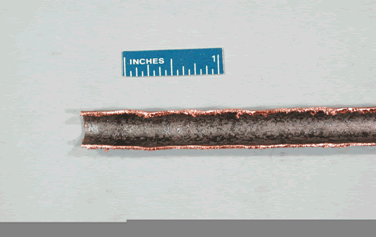 Figure 2. Close-up view of corrosion deposit on the inside of the bare copper sample after 52 weeks of accelerated test exposure.
Figure 2. Close-up view of corrosion deposit on the inside of the bare copper sample after 52 weeks of accelerated test exposure.The tin-lined copper tubing sample was visually inspected after being split lengthwise. The tin coating had discolored to charcoal black color with isolated pits. There were two areas where the protective tin coating exfoliated exposing the bare copper surface material underneath (Figure 3).
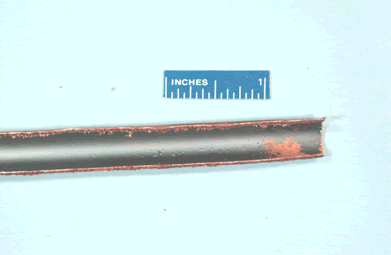 Figure 3. Close-up view of copper tubing sample with tin coating.
Figure 3. Close-up view of copper tubing sample with tin coating.Wall Loss Measurement
orrosion products formed on the surface of the copper tubing, primarily copper sulfide, were friable and broke easily from tubing wall; light tapping on the tubing wall was usually sufficient to dislodge the corrosion products from the tubing wall. It is possible that once a corrosion layer was removed to expose bare copper, sulfides in the gas stream could continue to react with the exposed copper to form another layer. This process gradually resulted in general tube wall loss over time; however the wall losses did not indicate a significant reduction in wall thickness for the samples exposed for 52 weeks. The amount of wall loss was estimated by tubing weight changes before and after exposure period, assuming that wall loss was uniform throughout. Weight loss from the bare copper sample was measured to be 3.06 grams and weight loss from the tin-lined sample was 0.71 grams respectively.
Corrosion Deposit Composition Analysis
Elemental mapping of the deposit was determined by using a scanning electron microscope with energy dispersive x-ray spectroscopy (SEM/EDX). The analysis of corrosion deposits revealed that it contained predominantly copper (Cu) and sulfur (S), which most likely were in the form of copper sulfide. A spectrum showing the results is attached in Appendix A. Close-up views of the surface morphology revealed that corrosion products formed on the bare copper sample was friable with cracks that could easily break away from the tubing wall (Figure 4). Similarly, the image for the tin-lined tube (Fiure 5) shows where the protective tin coating exfoliated and allowed formation of similar corrosion byproduct deposits in those areas and on the bare copper tubing.
 Figure 4. Close-up view of the surface morphology on the bare copper tubing.
Figure 4. Close-up view of the surface morphology on the bare copper tubing.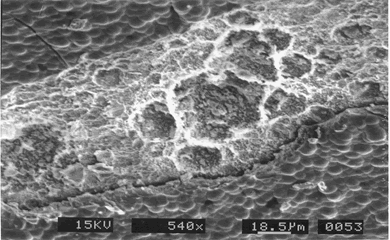 Figure 5. Surface morphology of the tin lined copper tubing.
Figure 5. Surface morphology of the tin lined copper tubing.Conclusions 
The acceptable useful service life of the copper tubing was defined as having a remaining wall thickness of greater than 80% of the nominal at the end of 20 years in service. For the standard ½” outside diameter, 0.05” thick wall copper tubing samples, the allowable wall loss was 10 mils.
As such, the wall loss was calculated on the basis of tubing sample weight measurements before and after the specified exposure period. Any localized corrosion resulting in pitting other than general surface wear was assessed as to the resulting penetration into the tube wall. The plot of the amount of wall loss versus exposure time (Figure 6) shows a projected wall loss at 20 years of service life for bare copper tubing was well below the 10 mils limit. Based on a uniform wall loss assumption, the data suggested that bare copper tubing would maintain structural integrity for the duration of its service life. However, examination of the interior surfaces of the bare copper tubing revealed that corrosion wall losses were not uniform. Several sites of localized pitting extending deeper into the tube wall were visible. The presence of these pits and their resultant effect on wall loss must be accounted for to ensure that these localized areas of pitting would not jeopardize the tubing wall and result in wall thickness less than that specified in the performance criteria.
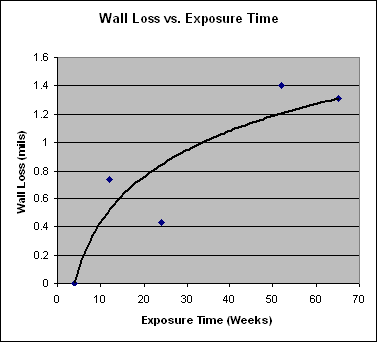 Figure 6. Plot of Wall Loss over the Period of Exposure for Bare Copper Tube.
Figure 6. Plot of Wall Loss over the Period of Exposure for Bare Copper Tube.Examination of these pitting sites indicates that while the pits are deeper than the surrounding general surface corrosion, they are still too shallow to be measured with available instruments. Thus they are not significant enough to exhibit a measurable difference in the expected service life and are not a cause for failure of the performance criteria. Also, the average wall loss after 20 years of projected usage is so small that the preferential corrosion sites would have to exhibit an increased corrosion rate approximately 35 times higher than the average rate to actually develop a pinhole in the accepted service life. If these sites had been corroding at this extreme rate, then the visible pits would have exhibited a measurably greater depth, which is not corroborated by the observed results.
Tin-lined copper tubing did not exhibit susceptibility to sulfide corrosion while the tin coating was in tact. It was clearly more resistant to corrosion than bare copper tubing, although there were isolated corrosion pits formed on the surface but no indication of deep penetration due to corrosion. However, two areas of tin coating failure were observed in which the unprotected copper tubing reacted in the gas stream to form copper sulfide. Regardless, the results indicate that the tin-lined copper is well within the performance criteria and can be expected to have a useful life much longer than the requisite 20 years indicated in this test. Also, the results indicate that the tin-lined copper tubing should not exhibit any significant potential for blockage of orifices, valves, or burners due to the release of significant amounts of friable corrosion products.
Corrosion Products
Corrosion products formed on the surface were friable and easily broke away from tubing wall. The amount of corrosion products trapped in the filter downstream did not clog or restrict gas flow. With longer lengths of bare copper tubing, as would be installed in a typical system, it is likely that a greater quantity of corrosion products would form and be available for transport downstream through the piping system. It is inconclusive that increases in the production of corrosion products due to longer lengths would actually lead to downstream blockage problems because the average size, consistency, and strength of these friable products were not determined. In most cases, the friable products were brittle and tended to break down into smaller pieces as it dislodged from the tubing wall.
In the case of tin-lined copper tubing, very minimal corrosion was observed, and in most cases the corrosion products generated were so minimal as to not be measured. This indicates that there is less likelihood that a system using tin-lined copper tubing will generate sufficient corrosion products to cause potential problems downstream.
Effects of Natural Gas Composition
Natural gas constituents identified as corrosive to copper were sulfur, H2S, water, CO2 and oxygen. The sampling results showed that most are within the recommended concentration limits specified in the Gas Company specifications except for the water moisture content sampled on February and August which exceeded the 7 lbs/MMscf limit. In addition the oxygen level in the gas increased significantly in the months of January and February. These could have affected the corrosion rate in the copper.
Overall Conclusion
Both the bare copper tubing and the tin-lined copper tubing evaluated in this test met the performance criteria to indicate that they will maintain structural integrity in the context of a 20-year useful life even though signs of sulfide corrosion were observed in the test samples. The extent of the observed corrosion was not severe enough to result in through-the-wall type corrosion.
Notes 
It should be noted that by participating in the preparation and publication of this report, the Southern California Gas Company takes no position on the suitability of utilizing non tin-lined copper tubing for natural gas house lines. The gas company participated as a provider of qualified test personnel and test facility, as a supplier of the gas that is supplied to homes in that part of the country and as a natural gas expert by virtue of its experience in this industry for the last several decades.
Also in this Issue:
- Useful Service Life Evaluation Testing of Copper Tubing for Gas Distribution System in California
- Copper - Something New Under the Sun?
